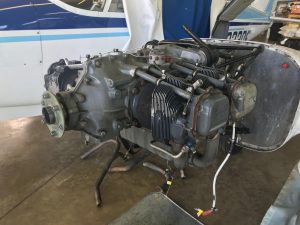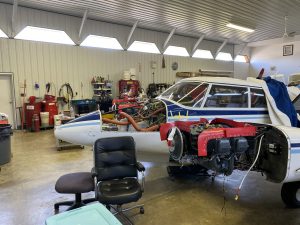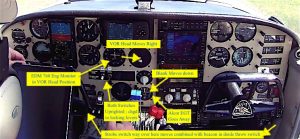N833DF is almost back! I am having trouble containing my excitement at the prospect of using these days home to go fly. This Wednesday I stopped to check on the progress of the overhaul and found both Paul and Ralph working hard inside and outside of the airplane.
The battery tender is sitting in position inside the nose now as Ralph is in the cockpit wiring the new engine monitor from the inside. The tender is still in its original packaging, but ready to go in when they get to it. The difficult to manage quarter-turn fasteners on the nose bonnet have been replaced at this point, with simple stainless screws.
The props were due back yesterday, and Paul thinks he might make enough progress to do a test run this week. I can’t get too excited because there is still so very much to do before I’ll get to fly it.
Light Switches: I’ve had a burr in my saddle concerning the placement of switches. Paul had installed a new switch for me years ago when I had him add wing tip strobes for me. I didn’t specify where to put the switch for those strobes, and it ended up on the extreme far right of the panel. Nowhere near the other light switches, and I found it to be aesthetically insulting. I like everything just so, and this was annoying. Today we agreed to combine this switch with a double pole switch. The down position would be beacon only, middle would be off, and up would be beacon and strobes. PERFECT!
Avionics Switches: If you go flying with me, you might notice that both my avionics master switch and my Aspen master switch are installed upside down, and are located right above the VOR Head. This was done because I had two instances where I inadvertently knocked off all of my avionics in the middle of a low instrument approach! When that happens, the entire panel except the Aspen goes dark.
The picture here shows the current installation with the VOR Head right under the avionics switches. The outages I described occurred as I was centering the course on the VOR Head when turbulence caused my extended arm to fly up. I knocked off both switches in one case (Aspen on Battery), and just the avionics panel in the other. When the panel goes completely dark all at once, the GPS loses its course immediately and you aren’t talking to anyone. The Aspen will retain the missed approach course it its memory, but you have to go around and reset the Garmin to the approach you are on and the missed you need. You are suddenly busy close to the ground.
When I get the airplane back, the VOR head will be moved to the right (next discussion), and that will help in and of itself. Additionally, these switches will be replaced with locking lever switches like my gear handle. Now an inadvertent bump will not affect you. You’ll have to pull them out first in order to change their position. Another satisfying solution.
VOR Head Movement: I had no idea that the temperature controller for the new EDM760 would be so large behind the panel. I just had a FlightStream 210 put in when I got the airplane back in January, and that might have been in the way a little as well. There isn’t allot of room behind (or in front!) of my panel. In order to fit this new engine monitor in, Paul had to move the VOR head further to the right by one position. I’m lucky there was enough room to put it in at all, since it wasn’t at all cheap to buy and I really wanted one.
Below are two repeat pictures that show the old and new left engines. Turns out that the clean baffles I spoke of in the last post were actually the ones I did. The work passed muster and did not need to be redone. I like it! 
On with the shiny and new!
 Fly Safe! I’ll be joining you very soon!
Fly Safe! I’ll be joining you very soon!
Frank

